Compare rates and fees for your money transfers.
Read our range of money transfer and banking guides.
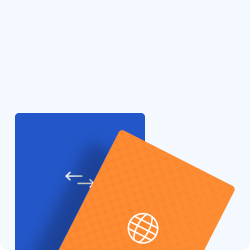
Reviews and comparisons of the best money transfer providers, banks, and apps.
Helpful tools to ensure you get the best rates on money transfers.

A Guide to Travel Money Cards
Often deemed the cheapest way to spend money abroad , travel money cards are deemed a failsafe option for many travellers. Given the rapid growth of the financial services sector, we want to find out if travel money cards are still as cutting edge as they once were, by comparing them to the new alternatives. Our job is to identify the best international money transfer services and payment providers in the industry: will travel money cards make the cut?
What are travel money cards?
Travel money cards are a popular payment method for individuals headed abroad. Customers will load funds onto the card, using the money as foreign currency when overseas, much like a debit card is used at home. Also known as travel money prepaid cards or currency cards, they facilitate free foreign transactions and overseas ATM withdrawals.
We recommend finding a travel money card which lets you lock-in a favourable exchange rate and supports multiple currencies on one card, to make sure you are securing a flexible and cost-effective deal.
How do you use a travel money card?
Using a travel money card should be straightforward and stress-free. Simply load funds onto the card before you leave, and once abroad, you will be able to reload funds and change currencies using the website or associated money transfer app . The card can be used to make withdrawals, in-store purchases and book travel arrangements.
Where can I get a travel money card?
Travel money cards are available from different retailers and can be purchased and preloaded online, over the phone or in-store, depending on the brand. In the UK, popular brands include Travelex and the Post Office.
Where can I use a travel money card?
Again, this depends on the brand and where you get your money travel card from. Available currencies vary from card to card but commonly used currencies include US Dollars, UK Pound sterling, Euros, Japanese Yen and New Zealand Dollars. Make sure you check with the provider before ordering a travel money card.
How secure are travel money cards?
Generally, travel money cards are considered a lot safer than handling multiple currencies in cash, or travellers cheques, as your provider will be able to cancel it if need be. Furthermore, some of the best travel money cards employ an equivalent level of security to traditional debit cards, including a PIN code, touch ID and face recognition.
Many consider it safer to use a travel money card abroad than a debit card, as they are not associated with your bank account and therefore cannot be linked if lost or stolen.
Travel money cards vs. Credit cards: What is the difference?
One of the biggest advantages of using a travel money card is that your chosen currency is preloaded before you arrive in the foreign country and you won’t be charged conversion fees. This means you are able to benefit from the most favourable exchange rates, locking it in ahead of time and using the funds at a later date.
Most people who use their credit card abroad do it because it is more convenient. The cost of this convenience, however, can sometimes amount to 3 - 5% per use, depending on the transaction and financial institution. Making a foreign ATM withdrawal with your credit card can incur flat-fees of $5 and up, each time.
This being said, there are some excellent traveller credit cards on the market, so we would recommend users compare exchange rates and transfer fees offered by each provider before making a decision on which card is more beneficial.
If you're planning on using your credit card, we suggest you take a look at our credit card wire transfer guide.
What are the alternatives to travel money cards?
Multi-currency accounts.
International money transfer companies are often tailoring their products and services to meet the needs of their customers. Wise , offers a multi-currency account designed with “international people" in mind. This savvy travel credit card is aimed at frequent flyers who want to spend in various currencies in over 200 countries. Wise is a reliable company to trust with your overseas spending habits.
Challenger banks
More and more alternative service providers are popping up around the world, many of them offering reputable banking features for the modern traveller. In a bid to distinguish themselves from traditional banks, challenger banks are scrapping fees on foreign exchange and international spending. Monzo customers, for example, can benefit from free international ATM withdrawals as well as fee-free spending overseas.

We hope this guide to travel money cards has enlightened you and helped you make a decision about whether this is a suitable payment method for your next trip overseas. We appreciate the value of your hard-earned cash and want all our customers to benefit from the best possible rates when dealing with international payments. Use our comparison tool today to make sure you are offered the most desirable exchange rate for your currency.
Related Content
- UK Passports Offer Better Travel Freedom Since Brexit The Henley Passport Index is an annual research project that evaluates the relative power of passports from 199 countries. It determines how many locations each passport allows its holders to access visa-free or with visa-on-arrival, creating a global ranking. June 5th, 2023
- Revealed: Summer Cruises Increase your CO2 Emission by 4700% per KM vs Train Travel Travelling by cruise ship rather than train this summer could increase passengers’ CO2 emissions each kilometre by 4716%, MoneyTransfers.com can reveal. June 5th, 2023
- Cheapest European city breaks on the British government’s exemption list The study incorporated numerous factors across a variety of areas including: February 15th, 2023
- 10 Years of Data Predicts the Go-to Holiday Destinations for Brits Now COVID Is Over To establish the expected changes to tourism and GBP(£) spend abroad going forwards, MoneyTransfers.com analysed 10 years' worth of UK travel data from the Office for National Statistics (ONS) - 2009 - 2019, to discover and predict where Brits will be travelling to in the next 10 years now that travel is well and truly back on again since Covid! February 19th, 2024
.jpg)
Contributors

April Summers

What Is A Visa Travel Money Card
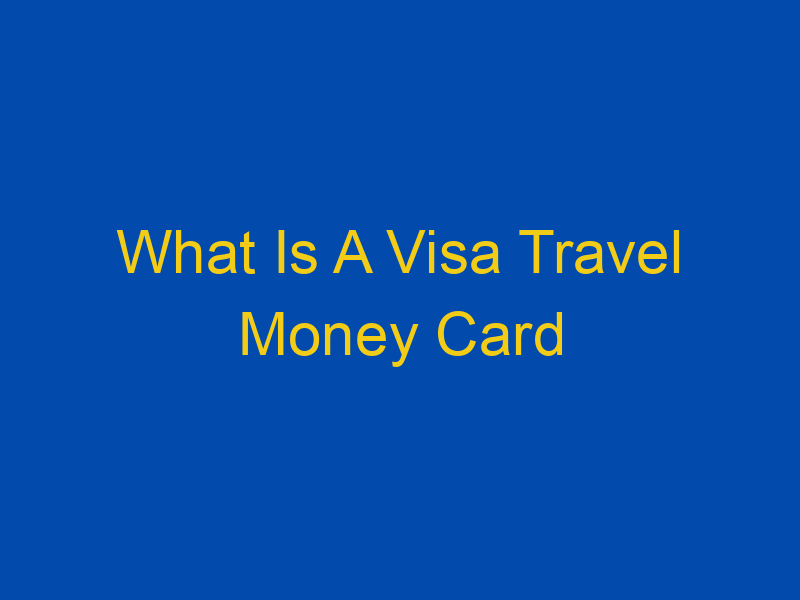
Sharing is caring!
I don’t know about you, but I hate carrying around cash when I travel. It’s bulky, it’s heavy, and worst of all, it’s easy to lose. That’s why I was thrilled when I discovered the Visa Travel Money Card.
This little piece of plastic has revolutionized the way I travel, and it could do the same for you! So what exactly is a Visa Travel Money Card?
In short, it’s a prepaid debit card that can be used just like any other credit or debit card while you’re traveling abroad. But unlike those cards, which are linked to your bank account and subject to foreign transaction fees and currency conversion rates, the Visa Travel Money Card allows you to load money onto the card in advance at a fixed exchange rate.
Not only does this save you money on those pesky fees and rates, but it also helps you stick to a budget since you can only spend what’s loaded onto the card. Pretty neat, huh? Let me tell you more!
Table of Contents
Definition of a Visa Travel Money Card
Discover the ultimate tool for hassle-free international purchases with the Visa Travel Money Card. It’s a prepaid card that allows you to load money onto it, which can then be used at any merchant that accepts Visa cards. It’s a convenient alternative to carrying cash and can be easily replaced if lost or stolen.
One of the advantages of using a Visa Travel Money Card is the ability to control your spending while traveling. You can only spend what you’ve loaded onto the card, which helps prevent overspending. Many travel money cards offer protection against fraud and theft, which is another added benefit. However, some merchants may not accept prepaid cards as a form of payment, so it’s important to have another method of payment on hand just in case.
Now let’s dive into how it works and how to get started with your own Visa Travel Money Card.
How it Works
So, let me tell you about how a Visa Travel Money Card works.
It’s essentially a prepaid debit card that you can load with money before your trip, without any link to your bank account.
This means you have control over your spending and don’t have to worry about overspending or going into debt while abroad.
Prepaid Debit Card
Using a prepaid debit card is like having a handy tool in your pocket for managing your expenses. One of the main advantages of using a prepaid card is that you can only spend the amount of money loaded onto it, helping you avoid overspending or going into debt. This makes it an ideal option for individuals who want to stick to a budget or have limited access to credit.
Another benefit of using a prepaid card is that it typically offers international currency conversion, making it easier and more affordable to make purchases while traveling abroad. Instead of carrying large amounts of cash or dealing with costly foreign transaction fees, you can use your prepaid card to pay for goods and services in local currency. Plus, many cards offer added security features such as fraud protection and the ability to lock your account if necessary.
One thing I appreciate about using a prepaid debit card is that there’s no link to my bank account. This means that even if my card were lost or stolen, my personal financial information would remain safe and secure. Additionally, since I can only spend what’s loaded onto the card, I don’t have to worry about overdraft fees or accidentally spending more than I have in my account.
Overall, using a prepaid debit card provides me with peace of mind and helps me better manage my finances on-the-go.
No Link to Bank Account
With the added benefit of keeping my bank account information safe, a prepaid debit card is an excellent tool for managing expenses on-the-go. As an avid traveler, I’ve learned that having alternative payment methods can come in handy when exploring different countries.
A Visa Travel Money Card is one such option that not only allows me to make purchases without carrying cash but also provides international currency exchange rates that are favorable compared to exchanging money at a bank. The Visa Travel Money Card does not require a link to my bank account, which ensures that my financial information remains secure even if the card is lost or stolen.
Additionally, it offers the convenience of reloading funds whenever necessary through online banking or mobile applications. With this feature, I can add more money to my card before my trip and avoid any hassle while traveling.
Loading Money Before Your Trip
Before heading out on a trip, it’s important to load funds onto your prepaid debit card. This is because 76% of travelers experience unexpected expenses while abroad. Loading money onto your Visa Travel Money Card is easy and convenient, as you can do it online or at participating stores.
Here are some best practices for budgeting and re-loading your card before your trip:
- Create a budget for your trip and determine how much money you’ll need on a daily basis.
- Load enough funds onto the card to cover your estimated expenses plus a little extra for emergencies.
- Set up automatic reloads so that you don’t run out of funds during your trip.
Using a Visa Travel Money Card also allows you to control your spending and stick to your budget. In the next section, we’ll discuss the benefits of using this type of card over traditional credit cards or cash when traveling.
Benefits of Using a Visa Travel Money Card
You can enjoy various advantages when using a Visa Travel Money Card for your overseas expenses. First and foremost, it provides convenience as you don’t have to worry about carrying cash or exchanging currency. You simply load the card with the amount you need before your trip, and you’re good to go. This saves you time and effort, especially when traveling to multiple countries where different currencies are used.
Moreover, using a Visa Travel Money Card offers security since it’s not linked directly to your bank account like a credit or debit card. In case of loss or theft, you can easily report it without risking losing all your money. Additionally, most travel money cards offer fraud protection which gives an added layer of security against unauthorized transactions.
With these benefits in mind, obtaining a Visa Travel Money Card is definitely worth considering for any traveler looking for a convenient and secure payment method on their trips abroad.
How to Obtain a Visa Travel Money Card
So, I decided to get myself a Visa Travel Money Card for my upcoming vacation. The application process was quite straightforward and only took a few minutes online.
However, I did have to pay some fees and charges such as activation fees, ATM withdrawal fees, and foreign transaction fees. Additionally, there were some limitations on the amount of money I could load onto the card and the places where it could be used.
Application Process
If you’re worried about a complicated application process, don’t be – applying for a Visa Travel Money Card is quick and easy. To get started, make sure you meet the eligibility requirements set by your bank or financial institution. These typically involve providing proof of identity and address, as well as meeting certain age criteria. Once you’ve confirmed your eligibility, the turnaround time for getting approved and receiving your card is usually quite fast.
The application process itself can vary slightly depending on where you apply from, but it generally involves filling out an online form or visiting a branch in person to apply. You’ll need to provide personal information such as your name and contact details, as well as choosing how much money you want to load onto the card initially.
After submitting your application and any necessary documentation, all that’s left to do is wait for approval and then activate your card once it arrives in the mail. With that done, you’re all set to use it for all kinds of travel-related expenses without having to worry about carrying cash or dealing with foreign exchange fees at every turn.
When it comes to fees and charges associated with a Visa Travel Money Card, there are some things to keep in mind before using it overseas. But we’ll talk more about that in the next section.
Fees and Charges
Be careful with the fees and charges associated with using a Visa travel money card, as they could potentially eat into your hard-earned travel budget. Here are some important things to keep in mind regarding fees and charges:
- Transaction fees may apply when you use your card for purchases or withdrawals in foreign currencies.
- ATM fees may also be charged by both the issuing bank and the foreign ATM provider.
Some cards may have monthly maintenance fees or inactivity fees if you don’t use them for a period of time. It’s important to read the fine print and understand all potential fees before applying for a Visa travel money card.
These fees can add up quickly if you’re not careful, so it’s important to plan ahead and budget accordingly. In the next section, we’ll discuss some limitations of using a Visa travel money card while traveling.
Limitations
You may feel frustrated by the restrictions and limitations that come with using a Visa travel money card while you’re abroad. One of the main disadvantages is that not all merchants accept it as a form of payment.
In addition, there are daily limits on how much you can withdraw from ATMs or spend at retailers, which can be inconvenient if you need to make a large purchase or pay for multiple items in one transaction. Another limitation is that some countries may have restrictions on certain types of transactions, such as online purchases or cash withdrawals.
Despite these limitations, there are still pros and cons to using a Visa travel money card. On the one hand, it provides added security because it’s not linked to your bank account like a debit card. On the other hand, it may not offer the same level of protection against fraud as a credit card.
As an alternative to using this type of payment method, you could consider carrying cash or traveler’s checks instead. However, both options come with their own risks and drawbacks. Ultimately, it’s important to weigh your options carefully before deciding how to manage your finances while traveling overseas.
When it comes to managing your finances while traveling overseas with a Visa travel money card, there are some important things to keep in mind.
How to Use a Visa Travel Money Card
Using this handy tool will make your travels a breeze, allowing you to easily access and manage your funds while on the go. When using a Visa Travel Money Card abroad, you don’t have to worry about carrying cash or dealing with complicated currency conversions.
Simply load the card with the desired amount of money in your home currency before departing, and use it just like a debit card at any merchant that accepts Visa. When making purchases or withdrawing cash from an ATM, the local currency will automatically be deducted from your balance, saving you time and hassle.
Plus, most cards come equipped with online banking services and mobile apps for easy tracking of transactions and balances. With all these features in one convenient package, a Visa Travel Money Card is definitely worth considering for anyone planning an international trip.
To get the most out of your Visa Travel Money Card, there are some tips to keep in mind. For example, always check exchange rates before loading funds onto the card to ensure you’re getting the best deal possible. Additionally, it’s important to keep track of fees associated with ATM withdrawals or transaction fees when making purchases.
By staying aware of these details and properly managing your account, you can enjoy all the benefits of using a Visa Travel Money Card during your travels.
Tips for Using a Visa Travel Money Card
Navigating the uncharted waters of international spending can be like sailing into a storm, but with these helpful pointers, you’ll be able to steer your financial ship with ease.
When using a Visa Travel Money Card abroad, always keep currency exchange rates in mind. Make sure you’re aware of the current exchange rate and any fees associated with converting your money. The card is an excellent way to avoid high foreign transaction fees that banks and credit card companies charge.
Another tip is to keep track of your balance regularly. Some merchants may not be able to tell you the exact amount left on your card, so it’s essential to monitor it yourself online or through their mobile app.
Also, don’t forget that some countries have different customs when it comes to tipping and paying for services like taxis or tours.
Lastly, make sure you inform your bank about your travel plans so they won’t flag any transactions as fraudulent activity. As we conclude this guide on tips for using a Visa Travel Money Card abroad, remember always to prioritize safety and security when traveling internationally with money. Keep copies of important documents such as your passport or ID in case of emergencies and never carry all of your cash or cards in one place.
With these useful pointers in mind, you’ll be able to enjoy hassle-free spending during your travels without worrying about hidden fees or unfavorable exchange rates.
Conclusion and Final Thoughts
Now that you’ve learned some valuable tips for spending internationally, it’s time to put them into action and confidently explore the world without worrying about financial setbacks.
One of the best ways to do this is by using a visa travel money card. Not only does it offer convenience and flexibility, but it also provides several benefits compared to traditional credit cards.
For starters, a visa travel money card allows you to load funds in advance. This means you can set a budget for your trip and avoid overspending or accumulating debt.
Additionally, since it’s not linked to your bank account or credit line, there is no risk of identity theft or fraud.
Lastly, most visa travel money cards come with competitive exchange rates and low transaction fees, making them more cost-effective than traditional credit cards when traveling abroad.
Frequently Asked Questions
How does the exchange rate affect the value of a visa travel money card.
When it comes to using a Visa travel money card, the exchange rate can have a significant impact on its value. This is because the card functions by converting your home currency into the local currency of wherever you’re traveling.
So, if the exchange rate between those two currencies isn’t favorable, you may end up getting less for your money than you anticipated. It’s important to keep in mind that the currency conversion process involved in using a travel money card typically involves fees as well, which can further affect its value.
Therefore, it’s always wise to research and compare exchange rates and fees before deciding on a particular travel money card to ensure that you get the best possible deal.
Can a Visa travel money card be used for online purchases?
Using a Visa Travel Money card for online purchases has its benefits and limitations. It’s like having a magical wand that you can use to pay for your purchases without the need to carry actual cash.
The benefit of using this card is that it provides convenience and security while shopping online. However, there are some limitations that come with it. For instance, not all merchants accept this form of payment, and there may be additional fees associated with the transaction.
Despite these limitations, using a Visa Travel Money card for online purchases can be an excellent option for those who enjoy the flexibility and simplicity of online shopping.
Are there any fees associated with withdrawing cash from an ATM using a Visa travel money card?
When using a Visa Travel Money card at an ATM to withdraw cash, it’s important to be aware of any associated fees. Some pros of using this type of card are that it can be more secure than carrying cash and can help you budget your travel expenses.
However, some cons include potential fees for ATM withdrawals and foreign transaction fees. To avoid these fees, it’s best practice to research ATM locations that waive or have lower withdrawal fees, and to notify your bank before traveling abroad to ensure the card will work in other countries.
Is it possible to reload a Visa travel money card while traveling abroad?
Reloading a Visa Travel Money Card while abroad is definitely possible, and it’s one of the many benefits of using this type of card for international travel. The Visa Travel Money Card offers increased security and flexibility when traveling outside your home country. Plus, reloading can be done through several methods such as online banking, mobile app, or at authorized reload centers.
Compared to traditional cards that come with exorbitant fees for foreign transactions and ATM withdrawals, the Visa Travel Money Card offers competitive exchange rates and lower transaction fees. It’s an excellent alternative for those who don’t want to carry large amounts of cash but still want access to their money while on the go.
What happens if a Visa travel money card is lost or stolen while traveling?
If my visa travel money card is lost or stolen while I’m traveling, the first thing I’d do is report it immediately to the issuer’s customer service hotline and follow their instructions.
It’s important to have a backup plan in case of such an event, so I always make sure to keep a copy of my card details and emergency contact numbers in a safe place.
To prevent loss or theft of my visa travel money card, I also take necessary precautions like keeping it secure in a wallet or pouch, avoiding displaying it publicly, and being aware of my surroundings when using it for transactions.
In conclusion, the Visa Travel Money Card is a reliable and convenient tool for any traveler looking to have easy access to their funds while abroad. It’s like having a mini bank in your pocket!
The feeling of not worrying about losing cash or dealing with foreign exchange rates is liberating. This card will allow you to enjoy your vacation without any financial stress.
Picture yourself on a beautiful beach in Bali, sipping on a colorful cocktail, and not having to worry about carrying around wads of cash or constantly searching for an ATM. That’s the kind of freedom that comes with a Visa Travel Money Card.
So go ahead and plan your next adventure with peace of mind knowing that your money is safe and accessible at all times with this amazing travel companion.

Meet Michael Graham, the main author of SeekTraveler.com. With a wanderlust that knows no bounds, Michael has traversed more than 30 countries across the globe. From sun-soaked Caribbean islands to the ancient marvels of Europe and the captivating charm of Japan, he has witnessed the wonders of diverse cultures firsthand. Michael’s in-depth knowledge and contagious enthusiasm for travel will inspire you to pack your bags and embark on your own extraordinary journey.
Related Posts

Expensive, Unique & Luxury Things To Do In Bali

Can You Travel Without A Driver’s License
- Credit cards
- Personal Finance
What Is A Travel Money Card?
How does a travel money card work?
How many currencies can you load at once, other features to compare, how to get a travel money card, when is a travel money card worth it, alternative options.
A travel money card, also called a prepaid travel card, is a type of card that can hold foreign currencies. It’s intended for overseas travel, and you can use one to withdraw foreign cash from ATMs and to make purchases in a local currency.
Think of a travel money card as a debit card that uses local currency. Before you use a travel money card, you’ll preload a set amount of a specific international currency onto the card at the day’s exchange rate. For example, if you’re travelling to Italy and France for two weeks, you’d load Euros (€) onto the card and use it instead of your regular debit or credit card during your trip.
You can continue reloading money onto the card via an app or website as you spend your funds. So, if you blow through your Euros in Rome, you can top off your card’s balance before arriving in Paris.
Understanding the value of your exchange
The value you exchange currency for will depend on when you load your funds. Rates change from day to day, but you’ll lock in the rate used at the time you exchange currency. So, you’ll know the exact worth of the foreign currency in Australian dollars every time you use your preloaded card.
On the one hand, a locked-in rate protects you from volatile currencies with fluctuating values. However, if the rate drops, you could be stuck with devalued foreign funds. So, while you can’t predict the future, try to coordinate the load when the exchange rate is most valuable — even if that means waiting a few days.
The number of foreign currencies available will depend on the company providing the card, but you’ll generally find a wide variety of options. Even if dozens of currencies are available, there are typically limits to the number someone can load onto a travel money card. These limits vary by card, but these cards generally only allow for about a dozen currencies at once.
For example, here are common travel money cards and the number of currencies they can support simultaneously:
- Australia Post Travel Platinum Mastercard: up to 11 currencies
- Cash Passport Platinum Mastercard (issued by Heritage Bank): load up to 11 currencies
- CommBank Travel Money Card: up to 13 currencies
- Qantas Travel Money Card: up to 10 currencies
- Travelex Money Card: up to 10 currencies
- Travel Money Oz Currency Pass Travel Money Card: up to 10 currencies
- Westpac Worldwide Wallet: up to 10 currencies.
The number of currencies available and the ability to load multiple currencies onto one card have obvious advantages: it helps you save on fees and makes it easier to manage your money while travelling overseas .
However, there are other key features to compare when choosing a travel money card.
Another thing to look for is reduced or waived fees for loading or reloading funds, account keeping, account closing and emergency card replacements.
Be sure to check for any potential fees when accessing leftover foreign funds you didn’t use on your trip, as there may be an unloading fee or an extra charge to withdraw funds and close your account. For example, Travelex charges a $4 monthly inactivity fee when the card hasn’t been used for more than 12 months.
Top-up options
How easy it is to use a financial product is typically important, but simplicity and convenience may feel more essential when you’re on holiday. In that case, options to quickly load or reload funds and notifications when your balance is low can be very helpful. Some cards may allow you to top up your balance immediately and with little cost. With others, you may have to wait a few days and pay a small fee.
Top-up methods also vary. For example, you can use BPAY with certain cards, but not all. Some cards may require you to use a specific app or portal. If convenience and flexible top-up options are important to you, compare options accordingly.
Perks and benefits
Travel perks, such as airport lounge access or the ability to earn rewards, are also great features to look for. Digital wallet compatibility, allowing you to use a virtual version of your card, can also be helpful.
Security and customer service
Security features are also important. Look for a card with a PIN to use at ATMs and the ability to lock the card instantly if lost or stolen.
And, since you’re travelling overseas, 24/7 customer support is essential to ensure you have access to help when you need it.
To get a travel money card , you can go through your bank, an airline, a foreign exchange retailer or a payment merchant.
Prepaid travel card eligibility is comparable to the requirements for a debit card. For example, CommBank requests that cardholders are at least age 14, are registered with NetBank, and provide a valid email and residential address.
You can apply directly on the provider’s website once you choose your favourite prepaid travel money card. Make sure to submit your application at least a few weeks before your trip in case of delays.
» MORE: How old do you have to get a credit card?
Activating the card
Once you receive the card:
- download the provider’s app and familiarise yourself with how it works
- register your account
- activate the card
- convert your money to the chosen currency. You might want to start with a smaller amount for the first part of your trip and reload while overseas or make one big transfer.
While overseas, you’ll likely alternate between paying in local cash and pulling out your travel card. Your goal is to find the best travel card that allows you to pay for items with minimal fees and maximum protections flexibly.
Possible advantages
- Provides access to multiple currencies. Most options allow you to convert Australian dollars into several different currencies simultaneously. That means you can have secure access to a handful of foreign funds during your next multi-country adventure.
- Saves on ATM fees. Credit card holders won’t usually be charged the standard 3% foreign transaction fee or pay extra for in-network ATM withdrawals, loading, and topping up their cards. However, these are just generalisations — each credit card company or bank will have its own fee structure.
- Exchange rates are locked. You’ll pay for the local currency using the exchange rate available when you load funds, which locks in the rate. Having dependable value for your funds goes a long way for peace of mind, especially when travelling.
- Fewer risks when lost. Losing a prepaid card while travelling is undoubtedly a hassle. However, a lost or stolen credit card can mean more risks, like thieves potentially accessing your personal banking details and account funds. Since a lost travel money card is unlikely to result in identity theft and fraud , some travellers find it a safer choice while abroad.
- Helps with budgeting. Trying to keep to preloaded funds may help you stick to a budget while on vacation. Plus, you see the value of money in the local currency, which can help you manage your finances while travelling.
- May come with rewards and perks. Some travel money cards earn frequent flyer points or come with other special travel perks, like overseas customer service. For example, the Qantas Travel Money Card earns Qantas points, and the Westpac Worldwide Wallet prepaid travel money card offers airport lounge access to the cardholder and one companion access when a flight is delayed.
Potential risks
- There are delays when reloading. If you need to top up your balance, you may need to wait up to a few days before funds are available to use.
- Other fees. Some travel money cards may levy typical credit card fees for reloading funds, emergency card replacement, account maintenance, closures, inactivity and more. For example, Travelex and the Australia Post Travel Platinum Mastercard charge a $10 account closing fee.
- Limited acceptance. Travel money cards are less common than other payment options, so you may need help using one for all purchases. So, it’s always a good idea to carry emergency cash.
- Typically lack rewards or major perks. Travel money cards may come with some, but these extras are usually less robust than the offerings on rewards credit cards .
The right travel money card supports a stress-free trip, but you don’t have to use one when travelling overseas — your bank card or credit card could also be a suitable option.
If you’re deciding between a travel money card and a travel credit card , it’s important to understand the differences in how they work.
- Travel money cards are preloaded with foreign currencies, while travel credit cards spend borrowed money. Travel money cards are generally easier to obtain as they don’t require good credit or income thresholds. With a travel money card, you can withdraw funds from an ATM without incurring interest or cash advance fees .
- Travel credit cards don’t usually hold foreign currency but offer perks such as international buyer protections, free insurance , airport lounge access and frequent flyer travel points .
Be sure to consider other important features — such as security, reduced fees and travel perks — to decide if a travel money card is worth it for you.
Frequently asked questions about travel money cards
The available currencies will depend on the card, but you’ll generally find the following options:
- United States Dollars (USD)
- Europe Euros (EUR)
- Great British Pounds (GBP)
- Japanese Yen (JPY)
- New Zealand Dollars (NZD)
- Hong Kong Dollars (HKD)
- Canadian Dollars (CAD)
- Singapore Dollars (SGD)
- Thai Baht (THB)
- Vietnamese Dong (VND)
- Chinese Renminbi (CNY)
- Emirati Dirham (AED).
Most Australian banks — including Westpac, CommBank, ANZ and NAB — have some sort of travel product, whether that’s a travel money card, a travel-friendly debit card or a travel credit card. However, ANZ and NAB no longer offer prepaid travel money cards.
About the Author
Amanda Smith is a freelance reporter, journalist, and cultural commentator. She covers culture + society, travel, LGBTQ+, human interest, and business. Amanda has written stories about planning for retirement for…
DIVE EVEN DEEPER
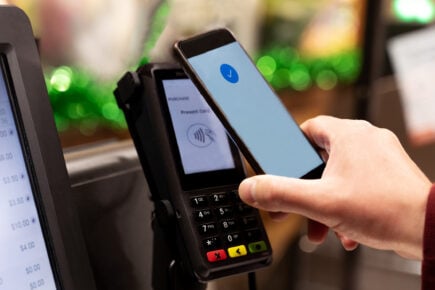
How Do I Pay With My Phone?
Instead of carrying your wallet around and pulling it out at check-out, you can just tap your phone, which is always on you, to pay for most things now.


What Is a Travel Credit Card?
Using a travel rewards credit card can help you get your next flight on a discount, hotel upgrades, or even cover the full cost of a trip.
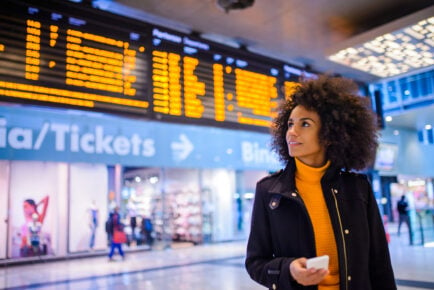
What Is a Frequent Flyer Program Credit Card?
Frequent flyer credit cards earn points or miles that can upgrade your travel and help you score free flights.

How To Lock, Block Or Freeze Your Credit Card
A card lock is essentially an on-off switch that allows you to temporarily freeze or block your credit card and most debit cards.
Here Are the Four Best Travel Money Cards in 2024

François Briod
Co-Founder of Monito and money transfer expert, François has been helping Monito’s users navigate the jungle of money transfer fees, bad exchange rates and tricks for the last ten years.
Jarrod Suda

A writer and editor at Monito, Jarrod is passionate about helping people apply today’s powerful finance technologies to their lives. He brings his background in international affairs and his experiences living in Japan to provide readers with comprehensive information that also acknowledges the local context.
Links on this page, including products and brands featured on ‘Sponsored’ content, may earn us an affiliate commission. This does not affect the opinions and recommendations of our editors.
From the multitude of bank fees and ATM charges to hidden currency conversion fees, there's no question that spending your money abroad while travelling can be costly — and that's saying nothing about the cost of the holiday itself!
As you prepare for your trip abroad, the golden rule is that you'll save the most money by using the local currency of your destination. This means withdrawing local cash at foreign ATMs and using a debit card to pay directly in the local currency. For example, if you're from the UK, using your bank's debit card that accesses your British pounds will likely lose you money to hidden fees at ATMs abroad and at local merchants.
In general, we rate Revolut as the best travel card all around. Its versatile account and card can be used to spend like a local pretty much anywhere in the world. ✨ Get 3 months of free Revolut Premium as a Monito reader with our exclusive link .
If you're from the EU, UK, or US, here are a few more specific recommendations to explore:
- Best for travelling from the UK: Chase
- Best for travelling from the US: Chime ®
- Best for travelling from the Eurozone: N26
If it's not possible for you to spend in the local currency when travelling abroad, then spending in your home currency while using a card that doesn't charge any hidden exchange rate markups from your bank (e.g. only the VISA or Mastercard exchange rates to convert currency) is still a good bet for most people.
In this guide, we explore cards that waive or lower ATM fees and that hold multiple currencies. Spend on your holiday like a local and enjoy peace of mind after each tap and swipe!
Best Travel Cards (And More!) at a Glance
Best travel money cards.
- 01. What is the best best multi currency card? scroll down
- 02. Are prepaid currency cards really it? scroll down
- 03. Monito's best travel money card tips scroll down
- 04. FAQ about the best travel cards scroll down
Revolut: Best All-Rounder
Revolut is one of the most well-known fintechs in the world because it offers services across Europe, the Americas, Asia, and Oceania.

- Trust & Credibility 8.9
- Service & Quality 7.9
- Fees & Exchange Rates 8.3
- Customer Satisfaction 9.4
Revolut is available in many countries. You can double-check if it's available in yours below:
Here's an overview of Revolut's plans:
Revolut Ultra is currently only available in the UK and EU.
Like Wise, Revolut converts your currency to the local currency of your travel destination at an excellent exchange rate (called the 'Revolut Rate', which, on weekdays, is basically on par with the rate you see on Google), making it a good way to buy foreign currency before travelling abroad. As always though, bear in mind that Revolut's exchange rates might be subject to change.
Revolut's Standard Plan only allows currency exchange at the base mid-market exchange rate for transfers worth £1,000 per month. ATM withdrawals are also free for the first €200 (although third-party providers may charge a withdrawal fee, and weekend surcharges may also apply). These allowances can be waived by upgrading memberships.
N26: Good Bank For EU Travellers
One of the most well-known neobanks in Europe, N26 and its debit card operate in euros only. However, N26 is a partner with Wise and has fully integrated Wise's technology so that you never have to pay foreign transaction fees on your purchases outside of the eurozone. While N26 does not have multi-currency functionality, N26 will apply the real exchange rate on all your foreign purchases and will never charge a commission fee — making N26's card a powerful card for EU/EEA residents who travel across the globe.

- Trust & Credibility 7.9
- Service & Quality 8.0
- Fees & Exchange Rates 9.3
- Customer Satisfaction 8.1
These are the countries in which you can register for an N26 account:
And here is an overview of the various plans and account:
This low-fee option for banking is also ideal for travellers who do not belong to a European bank but frequent the Eurozone. For example, N26 is available for residents and citizens of Switzerland, Norway, and other European Economic Area countries that do not run on the Euro.
These citizens, who are in close proximity to the Eurozone, will save each time they spend with an N26 card while in Europe. N26 provides three free ATM withdrawals per month in euros but does charge a 1.7% fee per ATM withdrawal outside of Europe.
Take a look at our guide to the best travel cards for Europe to learn more.
Wise: Best For Multi-Currency Balances
Load up to 54 currencies onto this card at the real exchange rate, giving you access to truly global travel.

- Trust & Credibility 9.3
- Service & Quality 8.9
- Fees & Exchange Rates 7.6
- Customer Satisfaction 9.6
These are the countries in which you can order a Wise debit card:
Unlike banks, credit unions, airport kiosks, and foreign ATMs, Wise is transparent about never charging a hidden exchange rate margin when you convert your home currency into up to 54 currencies. The live rate you see on Google or XE.com is the one you get with Wise.
An industry-low commission fee per transaction will range from 0.35% to 2.85%, depending on the currency.
Chase: Great UK Bank For Travel
A recent arrival from the USA, Chase is one of the UK’s newest digital challenger banks and comes with a rock-solid reputation and no monthly charges, no currency conversion charges, no withdrawal fees, and no other charges for everyday banking from Chase. It’s a simple, streamlined bank account with an excellent mobile banking app and a great cashback offer. However, it doesn’t yet offer more advanced features like international money transfers, joint accounts, business banking, overdrafts and loans, and teen or child accounts.

- Trust & Credibility 10
- Fees & Exchange Rates 10
- Customer Satisfaction 8.7
Chime: Great Account For US Travelers
Chime is a good debit card for international travel thanks to its no foreign transaction fees¹. Unlike multi-currency accounts like Revolut (which let you hold local currency), Chime uses the live exchange rate applied by VISA. This rate is close to the mid-market rate, and Chime does not add any extra markup to your purchases, although out-of-network ATM withdrawal and over-the-counter advance fees may still apply.

- Trust & Credibility 9.5
- Service & Quality 8.8
- Fees & Exchange Rates 9.8
While Chime waives ATM fees at all MoneyPass, AllPoint, and VISA Plus Alliance ATMs within the United States, this fee waiver does not extend to withdrawals made outside the country. For withdrawals abroad, Chime applies a $2.50 fee per transaction, with a daily withdrawal limit of $515 or its equivalent. This is in addition to any fees charged by the ATM owner. Therefore, we recommend Chime primarily for card purchases rather than relying on it for withdrawing cash while traveling internationally.
- No foreign transaction fees ¹;
- Uses VISA's exchange rate ( monitor here ):
- A $2.50 fee per ATM withdrawal made outside of the United States;
- More info: Read our Chime review or visit their website .
Best Travel Money Cards in 2024 Compared by Country
In the table below, see our comparison summary of the four best travel cards for 2024 by country:
Last updated: 8 January 2024
What's The Best Prepaid Card to Use Abroad?
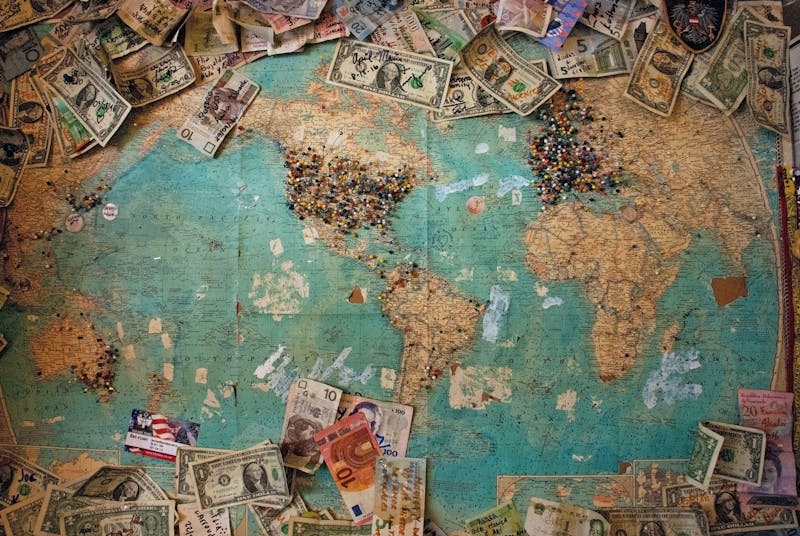
Travel cards come in many varieties, such as standard credit cards or debit cards with no foreign transaction fees or cards that waive all foreign ATM withdrawal fees.
What is a Multi-Currency Card?
Multi-currency cards are a specific type of travel card that allows you to own all kinds of foreign currencies, which you can instantly access when you pay with your card abroad. By spending the local currency in the region of travel , you bypass poor foreign exchange rates. ATMs and cashless payment machines will treat your card like a local card.
We have already mentioned a few multi-currency cards in this review, but we will also introduce Travelex . Travelex's Money Card also allows you to top up several foreign currencies — albeit at exchange rates slightly poorer than the real mid-market rate .
Wise Account
Wise has one of the best multi-currency cards available on the market.

Read our full review for more details.
Revolut is impressive for its vast options in currencies and its additional services.
Our in-depth review explores Revolut's services in detail.
Travelex offers a prepaid travel money card that supports 10 currencies and waives all ATM withdrawal fees abroad.

- Trust & Credibility 9.0
- Service & Quality 5.8
- Fees & Exchange Rates 7.1
- Customer Satisfaction 9.3
Travelex charges fees, which fluctuate according to the exchange rates of the day, in order to convert your home currency into the currencies that it supports. But once the currency is on the card, you'll be able to spend like a local. Learn more with our full review .
Don’t Let Banks, Bureaux de Change, and ATMs Eat Your Lunch 🍕!
Are you withdrawing cash at an ATM in the streets of Paris? Exchanging currencies at Gatwick airport? Paying for a pizza with your card during a holiday in Milano? Every time you exchange currencies, you could lose between 2% to 20% of your money in hidden fees . Keep reading below to make sure you recognize and avoid them.
Currency Exchange Fees Eating My Lunch? What’s That?
You’re often charged a hidden fee in the form of an alarming exchange rate.
At any given time, there is a so-called “ mid-market exchange rate ” — this is the real exchange rate you can see on Google . However, the money transfer provider or bank you use to exchange currencies rarely offers this exchange rate. Instead, you will get a much worse exchange rate. They pocket this margin between the actual rate and the poor exchange rate they apply, allowing the bank or money transfer provider to profit from the currency exchange.
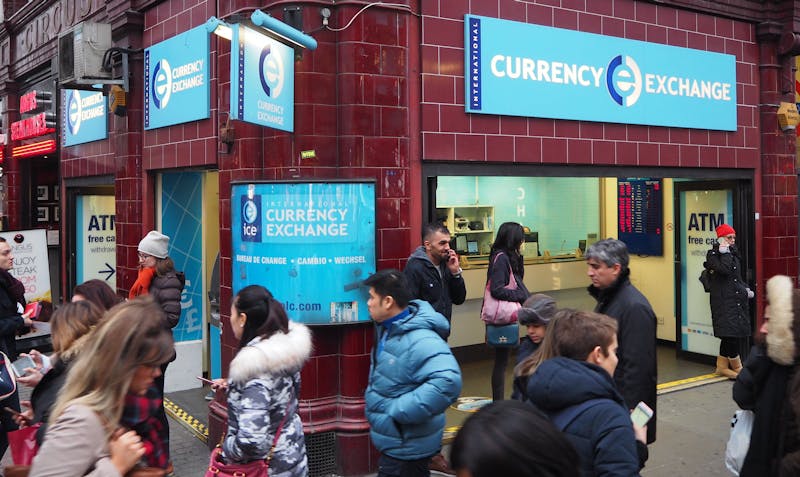
In other words, you or your recipient will receive less foreign currency for each unit of currency you exchange. All the while, the provider will claim that they charge zero commission or zero fees.
So the question now is… how can you avoid them? Thankfully, the best travel money cards will allow you to hold the local currency, which you can access instantly with a tap or swipe. Carrying the local currency avoids exchange rate margins on every purchase.
Top Travel Money Tips
- Avoid bureaux de change. They charge between 2.15% and 16.6% of the money exchanged.
- Always pay in the local currency and never accept the dynamic currency conversion .
- Don't use your ordinary debit or credit card unless it's specifically geared toward international use. Doing this will typically cost you between 1.75% and 4.25% per transaction. Instead, use one of the innovative travel money cards below.
By opting for a travel card without FX fees, you can freely swipe your card abroad without worrying about additional charges. However, saving money doesn't stop there. To make the most out of your travel budget, consider using Skyscanner , one of the most powerful flight search engines available that allows you to compare prices from various airlines and find the best deals.
With Skyscanner's user-friendly interface and comprehensive search options, you can discover cheap flights and enjoy your holidays with peace of mind and more money in your pocket.
Best Travel Money Card Tips

When you convert your home currency into a foreign currency, foreign exchange service providers will charge you two kinds of fees :
- Exchange Rate Margin: Providers apply an exchange rate that is poorer than the true "mid-market" exchange rate . They keep the difference, called an exchange rate margin .
- Commission Fee: This fee is usually a percentage of the amount converted, which is charged for the service provided.
With these facts in mind, let's see what practices are useful to avoid ATM fees, foreign transaction fees, and other charges you may encounter while on your travels.
Tip 1: While Traveling, Avoid Bureaux de Change At All Costs
Have you ever wondered how bureaux de change and currency exchange desks are able to secure prime real estate in tourist locations like the Champs-Élysées in Paris or Covent Carden in London while claiming to take no commission? It’s easy: they make (plenty of) money through hidden fees on the exchange rates they give you.
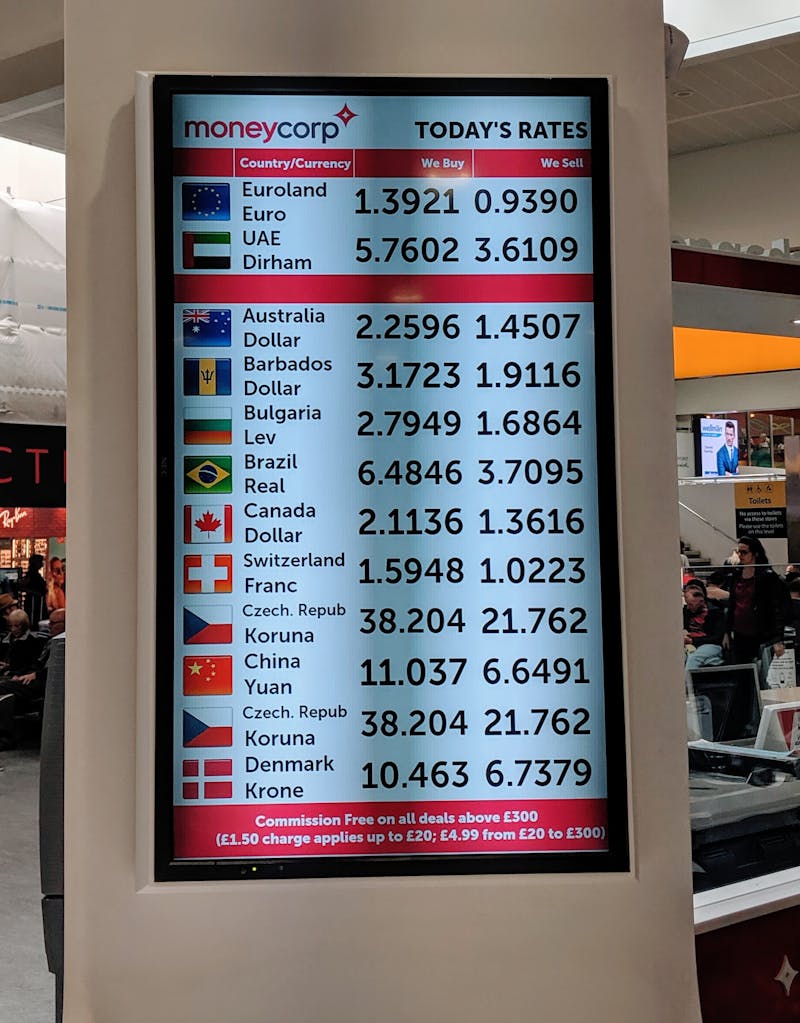
Our study shows that Bureaux de Change in Paris charges a margin ranging from 2.15% at CEN Change Dollar Boulevard de Strasbourg to 16.6% (!!) at Travelex Champs-Élysées when exchanging 500 US dollars into euros for example.
If you really want cash and can’t wait to withdraw it with a card at an ATM at your destination, ordering currencies online before your trip is usually cheaper than exchanging currencies at a bureau de change, but it’s still a very expensive way to get foreign currency which we, therefore, would not recommend.
Tip 2: Always Choose To Pay In the Local Currency

Don’t fall for the dynamic currency conversion trap! When using your card abroad to pay at a terminal or withdraw cash at an ATM, you’ve probably been asked whether you’d prefer to pay in your home currency instead of the local currency of the foreign country. This little trick is called dynamic currency conversion , and the right answer to this sneaky question will help you save big on currency exchange fees.
As a general rule, you always want to pay in the local currency (euros in Europe, sterling in the UK, kroner in Denmark, bahts in Thailand, etc.) when using your card abroad, instead of accepting the currency exchange and paying in your home currency.
This seems like a trick question - why not opt to pay in your home currency? On the plus side, you would know exactly what amount you would be paying in your home currency instead of accepting the unknown exchange rate determined by your card issuer a few days later.
What is a Dynamic Currency Conversion?
However, when choosing to pay in your home currency instead of the local one, you will carry out what’s called a “dynamic currency conversion”. This is just a complicated way of saying that you’re exchanging between the foreign currency and your home currency at the exact time you use your card to pay or withdraw cash in a foreign currency, and not a few days later. For this privilege, the local payment terminal or ATM will apply an exchange rate that is often significantly worse than even a traditional bank’s exchange rate (we’ve seen margins of up to 8%!), and of course, much worse than the exchange rate you would get by using an innovative multi-currency card (see tip #3).
In the vast majority of times, knowing with complete certainty what amount you will pay in your home currency is not worth the additional steep cost of the dynamic currency conversion, hence why we recommend always choosing to pay in the local currency.
Tip 3: Don't Use a Traditional Card To Pay in Foreign Currency/Withdraw Cash Abroad
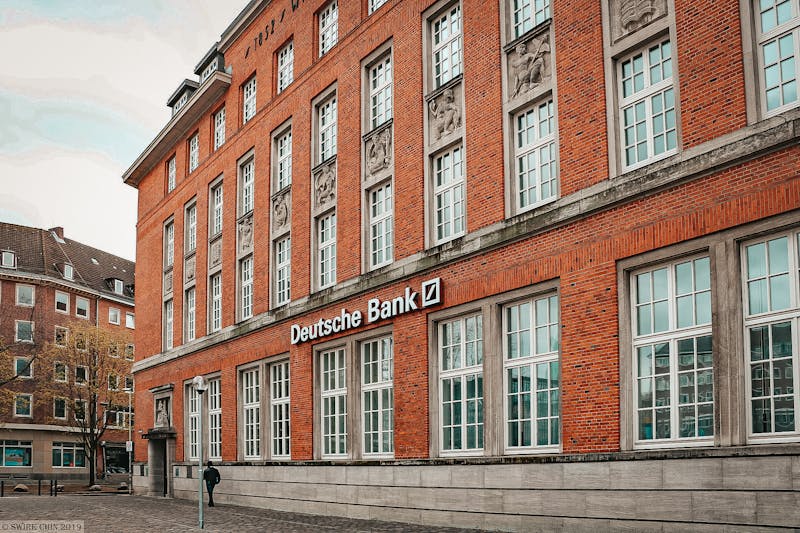
As mentioned before, providers make money on foreign currency conversions by charging poor exchange rates — and pocketing the difference between that and the true mid-market rate. They also make money by charging commission fees, which can either come as flat fees or as a percentage of the transaction.
Have a look at traditional bank cards to see how much you can be charged in fees for spending or withdrawing $500 while on your holiday.
These fees can very quickly add up. For example, take a couple and a child travelling to the US on a two-week mid-range holiday. According to this study , the total cost of their holiday would amount to around $4200. If you withdraw $200 in cash four times and spend the rest with your card, you would pay $123 in hidden currency exchange and ATM withdrawal fees with HSBC or $110 with La Banque Postale. With this money, our travellers could pay for a nice dinner, the entrance fee to Yosemite Park, or many other priceless memories.
Thankfully, new innovative multi-currency cards will help you save a lot of money while travelling. Opening an N26 Classic account and using the N26 card during the same US holidays would only cost $13.60.
Need Foreign Cash Anyway?
In many countries, carrying a wad of banknotes is not only useful but necessary to pay your way since not every shop, market stall, or street vendor will accept card payments. In these cases you'll have two options to exchange foreign currency cheaply:
1. Withraw at an ATM
As we've explored in great depth in this article, withdrawing money from a foreign ATM will almost always come with fees — at the very least from the ATM itself, and so it's therefore the best strategy to use a travel debit card that doesn't charge in specific ATM withdraw fees on its own to add insult to injury. That said, if you need cash, we recommend making one large withdrawal rather than multiple smaller ones . This way, you'll be able to dodge the fees being incurred multiple times.
2. Buy Banknotes (at a Reasonable Rate!)
As we've also seen, buying foreign currency at the airport, at foreign bank branches, or in bureaux de change in tourist hotspots can be surprisingly expensive. Still, not all exchange offices are equally pricey . If you're looking for a well-priced way to exchange your cash into foreign currency banknotes before you travel, Change Group will let you order foreign currency online and pick them up at the airport, train station, or a Change Group branch just before you leave for your holiday. A few pick-up locations in the UK include:
- London centre (multiple locations),
- Glasgow centre,
- Oxford centre,
- Luton Airport,
- Gatwick Airport,
- St. Pancras Station.
(Note that Change Group also has locations in the USA, Australia, Germany, Spain, Sweden, Austria, and Finland!)
Although its exchange rates aren't quite as good as using a low-fee debit card like Revolut, Change Group's exchange rates between popular currencies tend to be between 2% to 3%, which is still a lot better than you'll get at the bank or at a touristy bureau de change in the middle or Paris or Prague!
FAQ About the Best Travel Money Cards
Having reviewed and compared several of the industry's leading neobanks, experts at Monito have found the Wise Account to offer the best multi-currency card in 2024.
In general, yes! You can get a much better deal with new innovative travel cards than traditional banks' debit/credit cards. However, not all cards are made equal, so make sure to compare the fees to withdraw cash abroad, the exchange rates and monthly fees to make sure you're getting the best deal possible.
- Sign up for a multi-currency account;
- Link your bank to the account and add your home currency;
- Convert amount to the local currency of holiday destination ( Wise and Revolut convert at the actual mid-market rate);
- Tap and swipe like a local when you pay at vendors.
Yes, the Wise Multi-Currency Card is uniquely worthwhile because it actually converts your home currency into foreign currency at the real mid-market exchange rate . Wise charges a transparent and industry-low commission fee for the service instead.
More traditional currency cards like the Travelex Money Card are good alternatives, but they will apply an exchange rate that is weaker than the mid-market rate.
The Wise Multi-Currency Card is the best money card for euros because unlike banks, credit unions, airport kiosks, and foreign ATMs, Wise is transparent about never charging a hidden exchange rate margin when you convert your local currency into euros with them.
The live rate you see on Google or XE.com is the one you get with Wise . An industry-low commission fee will range from 0.35% to 2.85%. USD to EUR transfers generally incur a 1.6% fee.
Learn more about how to buy euros in the United States before your trip.
There are usually three types of travel cards, prepaid travel cards, debit travel cards and credit travel cards. Each have pros and cons, here's a short summary:
- Prepaid travel cards: You usually need to load cards with your home currency via a bank wire or credit/debit card top-up. You're then able to manage the balance from an attached mobile app and can use it to pay in foreign currencies or withdraw cash at an ATM abroad tapping into your home currency prepaid balance. With prepaid travel cards, as the name indicates, you can't spend more than what you've loaded before hand. Some prepaid card providers will provide ways to "auto top-up" when your balance reaches a certain level that you can customize. On Revolut for example, you can decide to top-up £100/£200/£500 from your debit card each time your balance reaches below £50.
- Debit travel cards: Some innovative digital banks, like N26 or Monzo, offer travel debit cards that have the same advantages than a Prepaid Travel Cards, except that they're debit card directly tapping into your current account balance. Like a Prepaid travel card, you can't spend more than the balance you have in your current account with N26 or Monzo, but you can activate an overdraft (between €1,000 or €10,000 for N26 or £1,000 for Monzo) if you need it, for a fee though.
Note that even if they're Prepaid or Debit cards, you can use them for Internet payments like a normal credit card.
- Credit travel cards: You can find credit cards made for international payments offering good exchange rates and low fees to withdraw money abroad, but you'll need to pay interests in your international payment if you don't pay in FULL at the end of every month and interest on your ATM withdrawals each day until you pay them back.
Why You Can Trust Monito
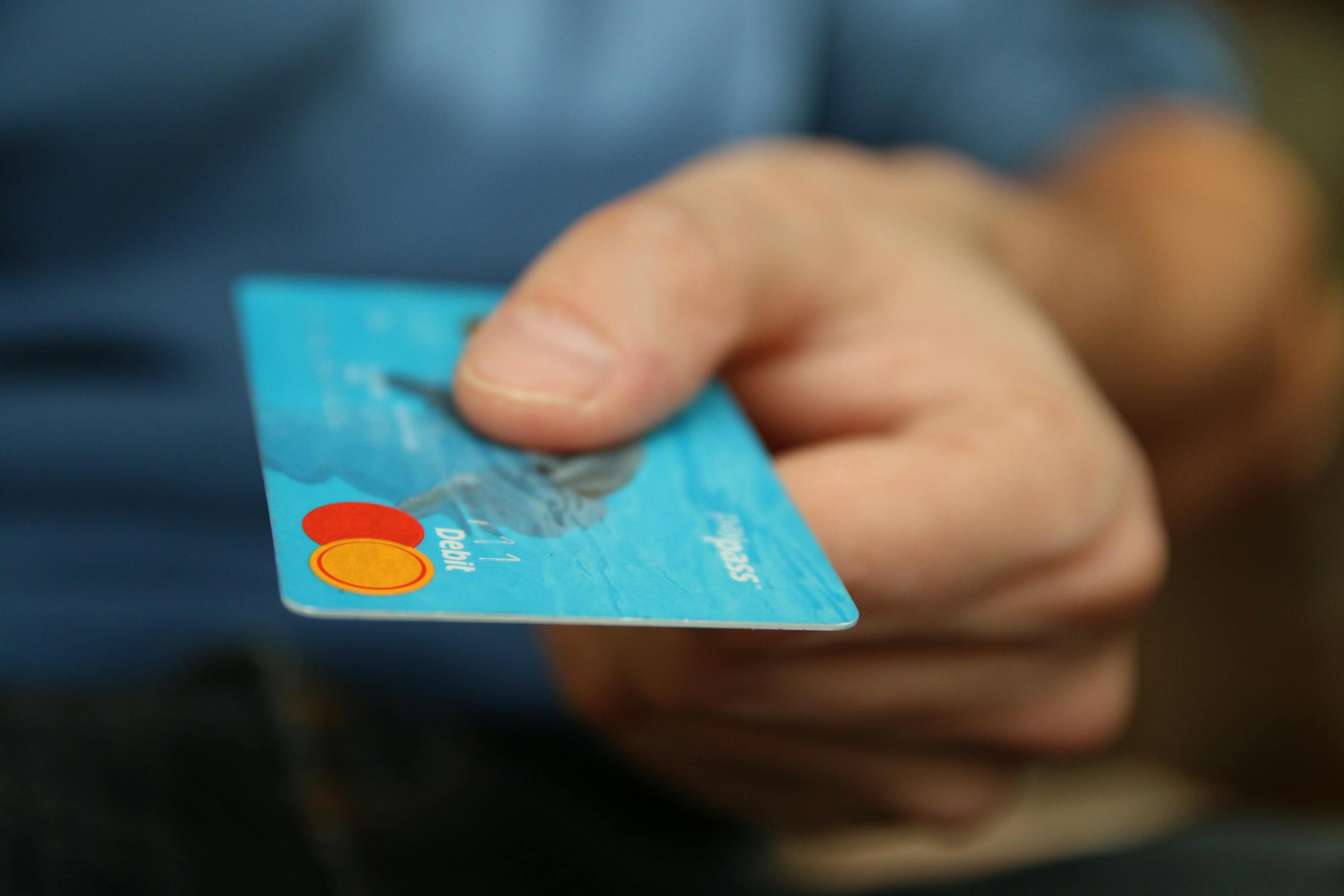
Our recommendations are built on rock-solid experience.
- We've reviewed 70+ digital finance apps and online banks
- We've made 100's of card transactions
- Our writers have been testing providers since 2013
Other Monito Guides and Reviews on Top Multi Currency Cards
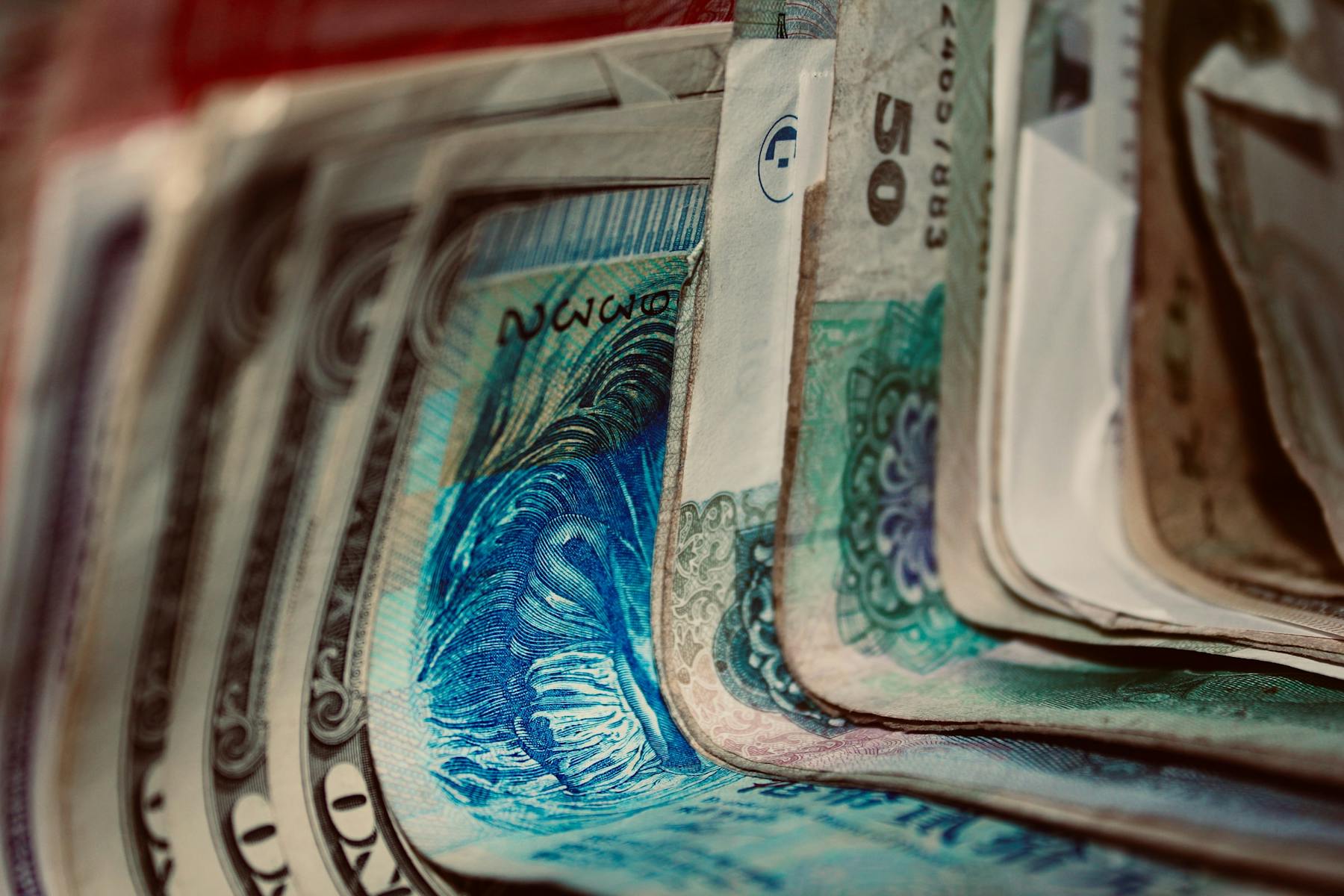
Why Trust Monito?
You’re probably all too familiar with the often outrageous cost of sending money abroad. After facing this frustration themselves back in 2013, co-founders François, Laurent, and Pascal launched a real-time comparison engine to compare the best money transfer services across the globe. Today, Monito’s award-winning comparisons, reviews, and guides are trusted by around 8 million people each year and our recommendations are backed by millions of pricing data points and dozens of expert tests — all allowing you to make the savviest decisions with confidence.
Monito is trusted by 15+ million users across the globe.
Monito's experts spend hours researching and testing services so that you don't have to.
Our recommendations are always unbiased and independent.

Pine Knoll Lodge & Cabins
Visa Travel Money Cards
A Visa Travel Money Card is a prepaid card that can be used for making purchases and withdrawals while travelling. It is a convenient alternative to carrying cash and travellers cheques.
The Visa Travel Money Card can be used at millions of merchant locations and ATMs around the world. It is also reloadable, so you can add more funds to it as needed.
The card comes with a number of features and benefits, including:
– 24/7 customer service
– No annual or monthly fees
– Chip and PIN technology for added security
– Can be used for online and in-store purchases
If you’re looking for a convenient, safe and easy way to carry money while travelling, a Visa Travel Money Card is a great option.
- 1 What is Visa Travel Money card?
- 2 How can I get travel Visa money?
- 3 Are there international prepaid Visa cards?
- 4 Which prepaid card is best for international travel?
- 5 Is it worth getting a prepaid travel card?
- 6 Can I use travel money card online?
- 7 Can I buy a $1000 Visa gift card?
What is Visa Travel Money card?
A Visa Travel Money card is a prepaid debit card that can be used for travel-related expenses. It is a convenient way to carry money when traveling, as it can be used at ATMs and for purchases in foreign currencies.
The Visa Travel Money card can be loaded with funds in a variety of currencies, and the exchange rate is locked in when the card is loaded. This means that the user does not have to worry about exchange rate fluctuations while they are on their trip.
The Visa Travel Money card can also be used to withdraw cash from ATMs, making it a convenient way to get cash while traveling. The card comes with a variety of features, such as chip and PIN technology, which makes it more secure than traditional debit cards.
The Visa Travel Money card is a convenient way to travel with money and avoid the hassle of exchanging currencies. It can be used at ATMs and for purchases in foreign currencies, and comes with a variety of features that make it secure and easy to use.
How can I get travel Visa money?
When traveling to a foreign country, it is important to have the appropriate visa. Many countries will require you to have proof of funds in order to obtain a visa. This can be in the form of a letter from your bank or a bank statement. In some cases, you may also be required to provide proof of your round-trip ticket.
If you need to obtain money for a travel visa, there are a few options. You can either withdrawal money from your bank account or get a loan from a bank or other lending institution. If you have a credit card, you can also use that to obtain a cash advance.
If you decide to get a loan, be sure to shop around for the best interest rate. You may also want to consider a personal loan, which may have a lower interest rate than a credit card.
Whatever option you choose, be sure to plan ahead and allow enough time to get the money you need.
Are there international prepaid Visa cards?
Prepaid Visa cards are a great way to control your spending, especially when travelling. But are there any international prepaid Visa cards?
Yes, there are a number of options when it comes to prepaid Visa cards that can be used internationally. Many cards are Multi-Currency cards, which means that they can hold multiple currencies on the one card. This can be really handy when travelling, as you don’t have to worry about currency exchange rates and can just use your card as you would any other Visa card.
There are a few things to keep in mind when looking for an international prepaid Visa card. One is that not all cards are accepted in every country, so you’ll need to check that the card you choose is accepted in the countries you’ll be visiting. You’ll also need to make sure that you have a good understanding of the fees and charges that come with the card, as these can vary from card to card.
Overall, prepaid Visa cards are a great option for travelling, and there are a number of cards available that can be used internationally. Just be sure to do your research and choose the card that’s right for you.
Which prepaid card is best for international travel?
Prepaid cards are a great way to manage your money when you’re travelling internationally. They offer a variety of benefits, including convenience, security, and flexibility. But which prepaid card is best for you?
There are a number of different prepaid cards available, so it’s important to do your research before you choose one. Some of the factors you’ll want to consider include the fees associated with the card, the currency that it supports, and the available withdrawal limits.
If you’re looking for a card that offers convenience and flexibility, the Travelex Money Card is a good option. This card can be used at millions of merchants around the world, and you can also withdraw cash from ATMs. The card has no fees for foreign transactions or for ATM withdrawals, and it supports eight different currencies.
If you’re looking for a card that offers a low-cost option for international travel, the CaxtonFX Currency Card is a good choice. This card has no fees for foreign transactions or for ATM withdrawals, and it supports 26 different currencies. However, the card has a £2.50 fee for ATM withdrawals in the UK.
If you’re looking for a card that offers the best value for your money, the Barclaycard Platinum Travel Card is a good option. This card has a low annual fee of £0, and it offers 0% interest on purchases for the first nine months. The card also has a number of other features, including a concierge service and travel insurance.
No matter which prepaid card you choose, it’s important to read the terms and conditions carefully before you use it. This will help you to understand the fees and restrictions that apply to the card.
When choosing a prepaid card for international travel, it’s important to consider the fees, the currency that it supports, and the available withdrawal limits. The Travelex Money Card, the CaxtonFX Currency Card, and the Barclaycard Platinum Travel Card are all good options for international travel.
Is it worth getting a prepaid travel card?
A prepaid travel card can be a great way to budget your money when you’re on vacation. They can also be a great way to avoid foreign transaction fees. But, is it worth getting a prepaid travel card?
There are a few things you should consider before you decide if a prepaid travel card is right for you. The first thing to think about is whether you’ll need to use it in more than one currency. If you’ll be spending time in multiple countries, a prepaid travel card may be a good option for you, as they usually offer better exchange rates than your average debit or credit card.
Another thing to consider is whether you’ll be able to use your prepaid travel card at all ATMs and merchant locations. Some cards are accepted at a limited number of ATMs and merchant locations, so you’ll want to be sure the card you choose has a wide acceptance.
Finally, you’ll want to think about how you’ll be using your card. If you’ll be using it mainly for emergencies, a prepaid travel card may not be the best option, as they often have fees associated with them. However, if you’ll be using your card for most of your purchases, a prepaid travel card can be a great way to budget your money and avoid foreign transaction fees.
Can I use travel money card online?
Yes, you can use a travel money card online.
A travel money card is a pre-paid debit card that can be used to withdraw cash or make purchases in foreign currencies. It is a convenient way to carry your money when travelling, as you don’t have to worry about exchanging currency when you arrive in a new country.
Most travel money cards can be used online, and some cards even offer rewards such as air miles or points for every dollar spent. Be sure to check the terms and conditions of your card before using it online, as some cards may have restrictions on how much you can spend or what currencies you can use.
It’s also important to note that when using a travel money card online, you will usually be charged a foreign transaction fee. This is a fee charged by the card issuer for every transaction made in a foreign currency. The fee can be anywhere from 2-5% of the transaction amount, so it’s important to factor this into your budget when travelling.
Overall, using a travel money card online is a convenient way to manage your money when travelling. Just be sure to familiarize yourself with the card’s terms and conditions, and be aware of the foreign transaction fees that may apply.
Can I buy a $1000 Visa gift card?
A Visa gift card can be a great gift for a loved one, or a helpful way to budget your expenses. But can you buy a $1000 Visa gift card?
The answer is yes, you can buy a $1000 Visa gift card. However, the gift card may not be available in all stores, so be sure to check ahead of time. You can also purchase a Visa gift card online.
When you purchase a Visa gift card, you’ll be given a code that can be used to redeem the value of the card. The code can be used at any store that accepts Visa cards.
The Visa gift card can be used for a variety of purposes, including online purchases, restaurant visits, and more. Be sure to read the terms and conditions of the card before using it, as some restrictions may apply.
A Visa gift card can be a great way to give someone the flexibility to use their money however they want. Be sure to give the gift card to the recipient in person, or send it to them in the mail.
Related Posts
Zurich to zermatt swiss travel pass, zodiac sign most likely to travel.
Whether to Use Cash, Credit, or Debit While Traveling
Traveling with money is a task that makes many people uneasy, especially when foreign currency is involved. Carrying cash abroad can be deemed as risky, but credit and debit cards can be notoriously finicky because of bank security and the fees that come with international credit charges can have a major effect on your funds in the long run. So, what's a poor old wandering soul to do?
These are questions to bring up with your bank, of course, but the safest method is perhaps to use them all. In other words: The "don't put all your eggs in one basket" saying applies. Using a mix of cash, credit, debit, and maybe even the odd traveler's check ensures that if the fees for one method are particularly astronomical, your bank account won't take as much of a toll. It also helps if one of your cards or a wad of cash is lost or stolen.
Cash is convenient and relatively cheap to exchange . You can take money from your home country into a foreign bank almost anywhere in the world and they'll easily exchange it without the worry of tiny bank fees adding up, pesky ATM fees, or losing out on a bad exchange rate. Alternatively, though, carrying coins and paper money is a security risk. When stolen, it cannot be replaced. The key is to have just a small amount of backup cash stashed away in a safe money belt.
If properly protected, a debit card can't be stolen as easily as cash. Debit cards can be used across many countries , although you should notify your bank of international usage first. Better yet, they can be used to retrieve cash—if the occasion calls for it—at an ATM and are all-around less bulky than carrying cash on your hip.
Be aware, however, that not all ATM machines (especially in more rural places) accept foreign debit cards and certainly not every restaurant and store will, either. Shops have been known to ban foreign debit altogether, so carrying a form of backup currency is always wise. Additionally, using debit regularly could lead to an accumulation of transaction fees. At ATMs, for instance, you'll be charged for converting funds into local currency and , if outside of your network, an additional ATM fee.
You may also need to change your PIN before you go, seeing as some countries' ATM machines can't process PINs with more than four digits. Others can't process ones with zeros. Lastly, before swiping your debit card abroad, educate yourself on ATM scams and learn how to avoid them.
Credit Cards
Like debit cards, credit cards are small and packable. They're replaceable and reliable. In fact, some hotels only accept authorization via credit, so this may be an integral method for you. MasterCard and Visa are widely accepted in other countries and you can use them for ATM transactions, too.
The bad news is that unscrupulous merchants can steal your credit card information and while you can dispute fraudulent charges and eventually get them removed from your account, the process can be grueling. You may need to cancel your card mid-trip to resolve fraud issues. It would be wise to also find out what your bank charges in international transaction fees before swiping your card haphazardly.
Prepaid Travel Cards
Prepaid travel cards like Visa TravelMoney look like credit cards but function more like a modern version of travelers checks. You simply load the card with money from your bank account and use it like a debit card at ATMs or like a credit card at merchants and hotels. They're locked with a PIN number, as your other cards are, for extra security, but they can sometimes be difficult to use at ATM machines. Additionally, fees for foreign currency transactions can be extremely high—as much as 7 percent in some cases.
Traveler's Checks
Although traveler's checks are historically secure and can be replaced if lost or stolen, they're hardly used anymore. Not many merchants or banks still accept them, even if they're written in their local currency. Merchants may charge you an additional fee for paying with traveler's checks, which are expensive to purchase in the first place (on top of the standard service fee, you'll also pay for shipping if you order them online). Not only are they one of the bulkiest means of payment to carry with you, they're one of the least useful, too.
Currency in Egypt: Everything You Need to Know
9 Tips for Using Your ATM card in Europe
The 11 Best Travel Money Belts of 2024
A Traveler's Guide to the Yen
What's the Best Way to Bring Spending Money to the UK?
Tips for Changing Your Money Abroad
Currency Converters
Using ATMs in Peru
Exchanging Currency in France
Tips for Using Debit and Credit Cards in Canada
Using Your Debit Card Overseas
Money in Germany
What Is an Exchange Rate and What Does It Mean?
How to Keep Your Money Safe While Traveling
How to Exchange Money in China
Rental Cars: Credit vs Debit Cards
- International edition
- Australia edition
- Europe edition

What is Fisa, and what does it mean for no-warrant spying?
After a week of debate, Congress on Friday reauthorized section 702 of the Foreign Intelligence Surveillance Act
Congress spent the past week in a fractious debate over a major government surveillance program that gives US authorities the ability to monitor vast swaths of emails, text messages and phone calls without a warrant. In a vote on Friday, lawmakers ultimately decided to keep that warrantless surveillance intact and passed a two-year reauthorization of the law, known as section 702 of the Foreign Intelligence Surveillance Act, or Fisa.
The law has long been contentious among both progressives and libertarian-leaning conservatives who view it as a violation of privacy rights and civil liberties. Donald Trump has likewise lambasted it out of personal grievance. Its defenders, which include intelligence agencies and Joe Biden’s administration, argue that it is an important tool in stopping terrorist attacks, cybercrime and the international drug trade.
What is section 702 of Fisa?
Section 702 is a measure added in 2008 to the Foreign Intelligence Surveillance Act, first passed in 1978, which allows authorities, including government agencies such as the NSA and FBI , to collect and monitor communications. More specifically, it gives them the authority to surveil the messaging of foreign citizens outside US soil and to do so without requesting a warrant.
Although section 702 was ostensibly intended to be used to monitor foreign terrorist groups and criminal organizations, law enforcement agencies have also used its authority to collect and surveil US citizens’ communications. This is because Americans messaging with people abroad are also liable to have their data accessed, which has led to improper use of the law and allegations from civil liberties groups that it gives authorities a backdoor into warrantless searches.
The law emerged from the George W Bush administration’s post-9/11 surveillance policies, adding government oversight to a secret program that had been monitoring foreign communications for years without formalized congressional approval.
Why is section 702 so divisive?
Section 702 has opponents on both sides of the political spectrum, with its critics especially concerned over the law’s ability to conduct warrantless searches of American citizens’ communications and law enforcement’s tendency to improperly overreach in its use.
Under section 702, authorities are only supposed to be able to search databases of communications for US citizens if they believe that the query could yield intelligence on malicious foreign actors or proof of a crime. But between 2020 and early 2021, the FBI improperly used section 702 almost 300,000 times in searches that targeted January 6 suspects, racial justice protesters and other American citizens, according to documents from Fisa court.
That misuse gave new life to calls for reforming section 702, potentially including requiring authorities to get a warrant from a judge before accessing US citizens’ communications. Civil liberties groups demanded numerous revisions, including closing loopholes that allowed the government to purchase information on US citizens through third-party data brokers.
Donald Trump’s campaign also reignited criticism of section 702, especially among far-right Republicans who tend to operate in lockstep with his pronouncements. The former president demanded that lawmakers “KILL FISA” in a post on Truth Social on Wednesday and accused authorities of using it to spy on his campaign – an apparent reference to an FBI investigation of a former campaign adviser of his that was unrelated to section 702.
Defenders of the law argued that there were already adequate provisions for stopping its misuse, and that requiring warrants or killing section 702 entirely would severely limit authorities’ ability to stop terrorist attacks and other crimes. Administration officials and backers of the reauthorization cited numerous US adversaries, from Chinese government spying operations to Islamist extremist groups, as reasons that warrantless surveillance was necessary for stopping urgent threats.
What happens to section 702 now?
The reauthorization of Fisa on Friday means that the program and warrantless surveillance will be able to continue for at least another two years. An amendment that would have required authorities to get a warrant for searches of US citizens narrowly did not pass, with a House vote ending in a 212-212 tie that resulted in its failure.
While the law was originally intended to be renewed for five years, Mike Johnson, the Republican speaker of the house, was forced to seek only a two-year reauthorization to mollify far-right GOP members who threatened to quash the bill entirely.
- Surveillance
- US Congress
- US politics
Most viewed

IMAGES
COMMENTS
AAA Visa travel money card's daily spending limit is $9,999 (or amount equivalent in Euros). This spend limit refers to the maximum cumulative point-of-sale signature or point-of-sale PIN transactions you can make per 24 hours. The maximum card balance that you can have at any time is also $9,999.
AAA Visa TravelMoney ® Card The AAA Visa TravelMoney Card is a reloadable, prepaid card which can be loaded from $100 to $9,999 and used to make purchases at millions of Visa® merchants, online or by telephone and to access cash in local currency at millions of ATMs worldwide. (1) Where can the AAA Visa TravelMoney Card be used?
Visa Travel Money is a prepaid card that is not linked to your bank account. Use the card to access only the funds you deposited in it before leaving on your trip. Take two cards with you for increased security and convenience. If you are accompanied by a travel companion or family member, check with your issuer institution if you can get more ...
Travel money cards are a popular payment method for individuals headed abroad. Customers will load funds onto the card, using the money as foreign currency when overseas, much like a debit card is used at home. Also known as travel money prepaid cards or currency cards, they facilitate free foreign transactions and overseas ATM withdrawals.
Travel money, for lack of a better term, essentially means the options of credit cards, debit cards, prepaid cards and foreign currency — all designed for travel and foreign transactions. Each form of travel money has different pros and cons, so you'll want to compare and contrast before choosing which'll be best for you and your itinerary.
The Visa Travel Money Card does not require a link to my bank account, which ensures that my financial information remains secure even if the card is lost or stolen. Additionally, it offers the convenience of reloading funds whenever necessary through online banking or mobile applications.
How Visa Travel Money works: step-by-step. 1. You apply for the International Prepaid Card at one of the companies that offer the service (banks or brokers); 2. You pay the issue fee, if any, and can now make the first load. Typically, you can charge via bank transfer or bank transfer payment; 3.
A travel money card, also called a prepaid travel card, is a type of card that can hold foreign currencies. It's intended for overseas travel, and you can use one to withdraw foreign cash from ...
In comparison to travel money cards, using your own bank's credit or ATM card is a simpler process. It provides direct access to the money in your bank account (or your credit card credit limit). You also benefit from having your money converted at the bank's wholesale exchange rate, rather a rate which can have hidden padding in it.
Travel money cards are designed specifically for travellers. It allows you to load and store a specific amount of money in multiple currencies onto the card before your trip. With Wise, you can order a travel money card and have it delivered to your home, or get a virtual card immediately on your phone. 1. Open an account in minutes 2.
Once you've purchased your card from your credit union, it's so simple to get started: Activate your card online by clicking here or via the toll-free number by calling the number on the back of your card. Follow the prompts to activate your card and create a PIN. Sign the back of card. You're now ready to use the card!
3. Pre-paid cards. Ease: 7/10. Cost-effectiveness: 8/10. Overall: 7.5/10. Pre-paid cards are quite simple, really. You upload currency (dollars, euros or whatever) onto the card, and you can then use it to withdraw money from ATM machines, or pay for goods in shops while you're abroad.
A travel money card — also known as a prepaid travel card, or a currency card — is easier and safer compared to carrying foreign currency in cash, and less complicated than using traveller's cheques. See for yourself. This comparison is based on comparing travel money with the Wise card vs exchanging cash for a holiday.
CUMONEY® Visa TravelMoney® card Is the Card the same as a credit card? No, this Card is not a credit card. You can only spend the amount of funds available on the Card. Is the Card like a debit card? Yes and no. Like a debit card, you may use the Card at participating merchants that accept Visa debit cards.
Find the best travel money cards to stop banks and ATMs charge fees on travel money while abroad. Compare fees and rates of the best multi currency cards. ... While Chime waives ATM fees at all MoneyPass, AllPoint, and VISA Plus Alliance ATMs within the United States, this fee waiver does not extend to withdrawals made outside the country. For ...
Order a travel money card for your American vacation is simple. Step 1. Create your free Wise account. Order your US dollar travel card for a one-time fee of $9 USD. Step 2. Choose currencies. Activate US dollar or any of the other 40+ currencies that we offer, and top your account up. Step 3.
A Visa Travel Money Card is a prepaid card that can be used for making purchases and withdrawals while travelling. It is a convenient alternative to carrying cash and travellers cheques. The Visa Travel Money Card can be used at millions of merchant locations and ATMs around the world. It is also reloadable, so you
Traveling with money is a task that makes many people uneasy, especially when foreign currency is involved. Carrying cash abroad can be deemed as risky, but credit and debit cards can be notoriously finicky because of bank security and the fees that come with international credit charges can have a major effect on your funds in the long run.
The law has long been contentious among both progressives and libertarian-leaning conservatives who view it as a violation of privacy rights and civil liberties.
Step 2. Order a card for a one-time fee of $9. Step 3. Start spending as soon as your card is activated. Order your card. Rest easy. Your money's safe. Freeze and unfreeze your card instantly. Generate digital cards for extra peace of mind.
For more than 60 years, Visa has focused on removing friction from payments, from point-of-sale to facilitating digital money movement around the world. Last year , we announced Visa+ , an innovative service that allows individuals to send and receive money quickly across different (P2P) digital payment apps and facilitates real-time payouts to ...
CUMONEY® Visa TravelMoney® Card and/or CUMONEY® Visa® Everyday Spend Card CUMONEY® Visa TravelMoney® Is the Card the same as a credit card? No, this Card is not a credit card. You can only spend the amount of funds available on the Card. Is the Card like a debit card? Yes and no. Like a debit card, you may use the Card at participating ...
A travel money card, also called a currency card, is a type of a card which allows you to keep multiple currencies, and use the card while travelling the world with no hidden fees to worry about. You can hold up to 40+ currencies in your travel money card, and convert them at the mid-market rate with the free Wise app.
The Visa credit card is one of the most popular in the world, accepted in more than 200 countries and territories. Visa Inc. (NYSE: V) operates one of the world's most advanced payment ...